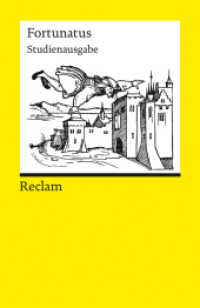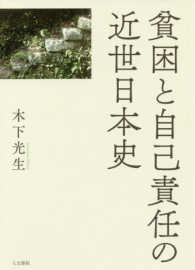- ホーム
- > 洋書
- > ドイツ書
- > Social Sciences, Jurisprudence & Economy
- > Education Science / Pedagogic
- > adult education
Full Description
This book highlights recent developments in literacy research in science teaching and learning from countries such as Australia, Brazil, China, Finland, Germany, Hong Kong, New Zealand, Norway, Singapore, Spain, South Africa, Sweden, Taiwan, and the United States. It includes multiple topics and perspectives on the role of literacy in enhancing science teaching and learning, such as the struggles faced by students in science literacy learning, case studies and evaluations of classroom-based interventions, and the challenges encountered in the science classrooms. It offers a critical and comprehensive investigation on numerous emerging themes in the area of literacy and science education, including disciplinary literacy, scientific literacy, classroom discourse, multimodality, language and representations of science, and content and language integrated learning (CLIL). The diversity of views and research contexts in this volume presents a useful introductory handbook for academics,researchers, and graduate students working in this specialized niche area. With a wealth of instructional ideas and innovations, it is also highly relevant for teachers and teacher educators seeking to improve science teaching and learning through the use of literacy.
Contents
Foreword, Elizabeth Moje.- 1 The expanding development of literacy research in science education around the world, Kok-Sing Tang and Kristina Danielsson.- Part 1 National Curriculum & Initiatives.- 2 The implementation of scientific literacy as basic skills in Norway after the school reform of 2006, Erik Knain and Marianne Ødegaard.- 3 But I'm not an English teacher! Disciplinary literacy in Australian science classrooms, Chris Davison and Sue Ollerhead.- 4 Meeting disciplinary literacy demands in content learning: The Singapore perspective, Caroline Ho, Natasha Rappa, and Kok-Sing Tang.- Part 2 Content and Language Integrated Learning (CLIL) in Science.- 5 Learning language and intercultural understanding in science classes in Germany, Silvija Markic.- 6 Supporting English-as-a-foreign-language (EFL) learners' science literacy development in CLIL: A genre-based approach, Yuen Yi Lo, Angel M. Y. Lin, and Tracy C. L. Cheung.- 7 Language, literacy and science learning for English language learners: Teacher meta talk vignettes from a South African science classroom, Audrey Msimanga and Sibel Erduran.- 8 The content-language tension for English language learners in two secondary science classrooms, Jason Wu, Felicia Moore Mensah, and Kok-Sing Tang.- Part 3 Science Classroom Literacy Practices.- 9 A case study of literacy teaching in six middle- and high-school science classes in New Zealand, Aaron Wilson and Rebecca Jesson.- 10 Analyzing discursive interactions in science classrooms to characterize teaching strategies adopted by teachers in lessons on environmental themes, Ana Lucia Gomes Cavalcanti Neto, Edenia Maria Ribeiro do Amaral, and Eduardo Fleury Mortimer.- 11 Measuring time. Multilingual elementary school students' meaning-making in physics , Britt Jakobson, Kristina Danielsson, Monica Axelsson, and Jenny Uddling.- 12 Meaning-making in a secondary science classroom: A systemic functional multimodal discourse analysis, Qiuping He and GailForey.- Part 4 Science Disciplinary Literacy Challenges.- 13 Literacy challenges in chemistry: A multimodal analysis of symbolic formulas, Yu Liu.- 14 Gains and losses: Metaphors in chemistry classrooms, Kristina Danielsson, Ragnhild Löfgren, and Alma Jahic Pettersson.- 15 Image design for enhancing science learning: Helping students build taxonomic meanings with salient tree structure images, Yun-Ping Ge, Len Unsworth, Kuo-Hua Wang, and Huey-Por Chang.- Part 5 Disciplinary Literacy & Science Inquiry.- 16 Inquiry-based science and literacy: Improving a teaching model through practice-based classroom research, Marianne Ødegaard.- 17 Infusing literacy into an inquiry instructional model to support students' construction of scientific explanations, Kok-Sing Tang and Gde Buana Sandila Putra.- 18 Representation construction as a core science disciplinary literacy, Russell Tytler, Vaughan Prain, and Peter Hubber.- Part 6 Science Teacher Development.- 19 Science and language experience narratives of pre-service primary teachers learning to teach science in multilingual contexts, Mariona Espinet, Laura Valdés-Sanchez, and Maria Isabel Hernández.- 20 Examining teachers' shifting epistemic orientations in improving students' scientific literacy through adoption of the Science Writing Heuristic approach, Brian Hand, Soonhye Park, and Jee Kyung Suh.- 21 Developing students' disciplinary literacy? The case of university physics, John Airey and Johanna Larsson.- 22 Commentary on the expanding development of literacy research in science education, Larry Yore.








